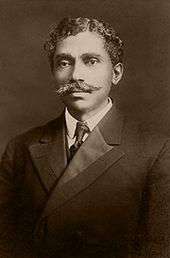Pope House Museum
|
Dr. M.T. Pope House | |
 | |
  | |
| Location | 511 S Wilmington St., Raleigh, North Carolina |
|---|---|
| Coordinates | 35°46′24″N 78°38′19″W / 35.77333°N 78.63861°WCoordinates: 35°46′24″N 78°38′19″W / 35.77333°N 78.63861°W |
| Area | 0.1 acres (0.040 ha) |
| Built | 1900 |
| Architectural style | Two-story gable front |
| NRHP Reference # | 99001392[1] |
| Added to NRHP | November 22, 1999 |
The Pope House Museum, built in 1901, is a restored home once owned by Dr. M.T. Pope, a prominent African-American citizen of Raleigh, North Carolina. The Pope House is listed on the National Register of Historic Places in 1999, and was also an official project of the Save America’s Treasures Program.[2] Since then, the city of Raleigh has taken over management of the Pope House Museum and opened it for tours for the first time.[3]
Since the early 19th century, the area where the Pope House is located has gone through many transformations. When the original governor’s mansion was built at the end of Fayetteville Street on the site of the present Memorial Auditorium, it was thought that fashionable residences would be built nearby. Although a few substantial homes were constructed by white families, when Reverend Henry Tupper moved Shaw University to the neighborhood in 1870, many new African-American residents drawn to Raleigh after the Civil War settled in the area. Pope attended Leonard Medical Center at Shaw University before beginning his medical practice.[4]

Black professionals began to build homes in the area known as the Third Ward, which included the 500 block of South Wilmington Street. In 1901, Pope decided to build his house in this area.[5] Pope’s neighbors included other prominent African Americans, including another doctor and a pharmacist. His home was located near his office on East Hargett Street, which at the time was the heart of the black business district.[6]
Pope installed the latest technology in his home, including combination gas and electric fixtures, a kitchen with running water, a full bathroom on the second floor, coal burning heating stoves, and a telephone. He also installed a call bell system, with buttons in each room and an annunciator in the back hall. Pope began to see patients in the house during the 1920s and 1930s, when his health began to fail. The small area at the rear of the back hall, adjacent to the kitchen, was configured to include a small hand sink and built-in cabinet for instruments.
After Pope married Delia Haywood Phillips in 1907, the couple added a garage and wired the home for electricity. In the 1920s, the original front porch was removed, and the current sleeping porch constructed on brick piers. In the 1940s, the northern half of the first floor space below the porch was enclosed with brick, as it remains today. They eventually had two children, Evelyn and Ruth. After the deaths of their parents, Evelyn and Ruth maintained the family home, though they lived in Durham and Chapel Hill respectively.
Although the Pope House remains in the neighborhood, the area around it has dramatically changed. Older homes and businesses were replaced with office buildings, parking lots and newer homes. The most evident change was the construction of the Raleigh Convention Center directly across the street from the house. Today, the house is in the shadows of skyscrapers that were built in the 1980s and 1990s.
The Pope House was officially listed on the National Register of Historic Places on November 22, 1999. The following month the trustees of the Pope Charitable Foundation decided to begin the process of turning the house into a museum. One month later, The Pope House Museum Foundation was incorporated as a non-profit organization. The extensive family papers were sorted and catalogued, and donated to the Southern Historical Collection at the University of North Carolina at Chapel Hill. In 2011 due to financial concerns, the Pope House Museum approached the city of Raleigh about purchasing the Pope House Museum to ensure its survival. Since the purchase, the Pope House Museum has been managed by Raleigh Parks and Recreation which has opened the Pope House Museum for regular tours for the first time.[7]
See also
Further reading
Kenneth Joel Zogry (2008). The House that Dr. Pope Built: Race, Politics, Memory and the Early Struggle for Civil Rights in North Carolina (Thesis). Department of History, University of North Carolina at Chapel Hill. ISBN 978-0-549-53244-6.
References
- ↑ National Park Service (2010-07-09). "National Register Information System". National Register of Historic Places. National Park Service.
- ↑ "The Pope Museum House Foundation". Thepopehousemuseum.org. Retrieved 2012-05-18.
- ↑ Campbell, Colin. "Pope House Museum reopens for Saturday Tours". North Raleigh News. Retrieved 2012-10-30.
- ↑ Shaw University
- ↑ "Pope House -Setting the Stage". Nps.gov. Retrieved 2012-05-18.
- ↑ Kenneth Joel Zogry (May 1999). "Dr. M.T. Pope House" (pdf). National Register of Historic Places - Nomination and Inventory. North Carolina State Historic Preservation Office. Retrieved 2015-05-01.
- ↑ "Pope House Museum". City of Raleigh.
External links
- Official website
- An American Success Story: The Pope House of Raleigh, NC, a National Park Service Teaching with Historic Places (TwHP) lesson plan
- Inventory of Pope Family Papers, UNC-CH Southern Historical Collection

